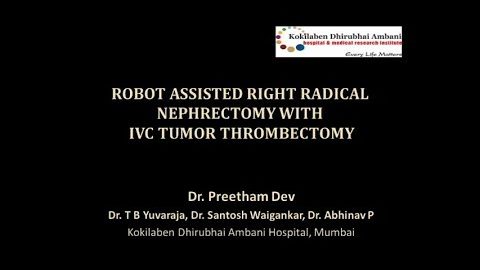Robotic Enucleation of Renal Hilar Tumour
Robotic Enucleation of Renal Hilar Tumour
This video was awarded Third Prize in the KS National Robotic Surgery Video Awards for 2019 at the Robotic Surgeons Council of India, November 2019, Pondicherry. It was produced by Vattikuti Fellow Dr. Aditya A. Kulkarni, under the mentorship of Dr. Ashwini Kudari. From the Abstract:
Robotic Enucleation of Renal Hilar Tumour
By: Aditya A. Kulkarni, Muralidhar Achar, Prashanth Kulkarni
Affiliation: Mazumdar Shaw Cancer Centre, Narayana Health City, Bengaluru
Background: Minimally invasive nephron-sparing surgery (NSS) using the daVinci surgical robot is increasingly being performed for incidentally detected renal masses with excellent outcomes. Tumors with exophytic morphology and peripheral location are ideal indications for NSS. However, tumors in central location remain a surgical challenge. In this video, we present our approach for enucleation of a hilar tumor straddling the renal vessels.
Methods: A 31 year old male presented with incidentally detected right renal mass. Ultrasound and CT abdomen were performed, which were suggestive of 2.5 x 2.4cm heterogeneously enhancing mass lesion consistent with renal cell carcinoma abutting right renal pelvis and collecting system in close proximity to renal vessels and branches. Robotic partial nephrectomy/ enucleation was planned. DaVinci Si robotic surgery system was used. Patient was placed in lateral position. Two robotic ports (8mm), one camera port (12mm) and two assistant ports were placed. Hilar dissection was performed and renal artery and vein were looped. Renal artery was branching into three branches and tumour was located in between arterial branches. The tumour could be separated off the branches and feeders were coagulated. The tumor was enucleated by blunt dissection and scissors using the natural cleavage plane between the pseudocapsule and normal parenchyma.
Results: Total operative time was 210minutes. Intra-operative blood loss was 150 ml. As we did not use hilar clamping, there was no warm ischemia to the kidney. The postoperative recovery was uneventful, and patient was discharged on third postoperative day. Histopathology surprisingly revealed “anastomosing hemangioma” with no evidence of malignancy. At follow-up, the serum creatinine was normal and patient was asymptomatic.
Conclusion: In case of renal hilar tumours closely abutting renal vasculature, thanks to image magnification, endo-wrist movements, motion scaling and tremor filtration, the Da Vinci Surgical System allows performance of enucleation in a feasible and safe manner.
Video of robotic surgery with PPT’s, MRI, diagrams & photos, 07:54
Date
August 15, 2020



